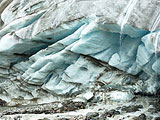Climate Change, That Slippery Slope
By Claudio Guler for ISN
A choice topic to spoil dinner parties and a long-standing, legitimate source of concern among scientists and well-informed policymakers, abrupt climate change - climate events that unfold faster than the pace at which humans can adapt to them - was the focus of a December 2008 report released by the external pageUS Climate Change Science Programcall_made, a collaborative project of relevant US government agencies scrutinizing the four most pressing scenarios.
A relatively high degree of indeterminacy characterizes each scenario. Nevertheless, the potential downsides make for sober reading. Here then, an overview.
Scenario A: Ice melts and sea levels. Noting the historically inverse relationship between atmospheric concentrations of carbon dioxide and sea levels, the report argues that “although no ice-sheet model is currently capable of capturing the glacier speedups [i.e. accelerated melting] in Antarctica or Greenland that have been observed over the last decade, including these processes in models will very likely show that IPCC Assessment Report 4 projected sea level rises [9 to 88 cm] for the end of the 21st century are too low.” The complexity of the climate refugee challenge looks set to grow.
Scenario B: Water supply and shortages. Hydrological scientists have long identified protracted droughts and water shortages in the subtropics as a likely outcome of climate change. The report agrees with this viewpoint and adds that the processes might already have begun. For example, the American Southwest, parts of East Africa and Australia have as of late witnessed exceptionally dry years.
Scenario C: Disruption of the Atlantic Meridional Overturning Circulation (AMOC). The AMOC transfers significant heat from the tropics to the North Atlantic and likely plays an important role in maintaining Europe’s temperate climate. The report concludes that a decrease in the strength of the AMOC due to increasing greenhouse gas concentrations in the atmosphere, possibly by 25-30 percent, is very likely over the course of the 21st century, but a collapse or abrupt transition to a weaker state is very unlikely. Beyond the 21st century, the report argues that a collapse of the AMOC is also unlikely but cannot be entirely excluded.
Scenario D: Abrupt changes in the atmospheric concentration of methane. Methane in the atmosphere, the second most important greenhouse gas after carbon dioxide and responsible for roughly 20 percent of all warming (methane exhibits 25 times the warming potential of carbon dioxide over a 100 year period), has more than doubled since the pre-industrial age - 700 parts per billion to over 1,780 ppb. external pageFlatulent livestockcall_made is interestingly enough the primary source of anthropogenic atmospheric methane, but the relevant concern here is that higher temperatures could lead to a sudden release of trapped methane, creating so-called positive feedback loops that accelerate climate change, possibly inexorably.
The primary sources of a potential rapid methane release are melting permafrost in Alaska and Siberia and methane clathrates in shallow waters, mainly in the Arctic. The report concludes rather ambiguously that “While the risk of catastrophic release of methane to the atmosphere in the next century appears very unlikely, it is very likely that climate change will accelerate the pace of persistent emissions from both hydrate sources and wetlands. Current models suggest that wetland emissions could double in the next century. However, since these models do not realistically represent all the processes thought to be relevant to future northern high-latitude CH4 emissions, much larger (or smaller) increases cannot be discounted. Acceleration of persistent release from hydrate reservoirs is likely, but its magnitude is difficult to estimate.”
These scenarios all imply significant global security risks and underscore the need for Washington to legislate a comprehensive energy and environment policy - a necessary step to ensure emerging emitters China and India that they are operating on a level playing field and a prerequisite for global climate policy to move forward.
On 22 July, US Congressional external pageDemocrats announcedcall_made that in the face of mounting bipartisan opposition, the time had come to throw in the towel on cap and trade legislation. This is hardly all bad news. A cap and dividend solution, as proposed by the CLEAR Act now in the US Senate, makes for a far more sensible and politically attractive fix.
An end has made way for a new beginning. And with the disruptive potential of abrupt climate change scenarios in mind, members of the US Congress should seize it.

